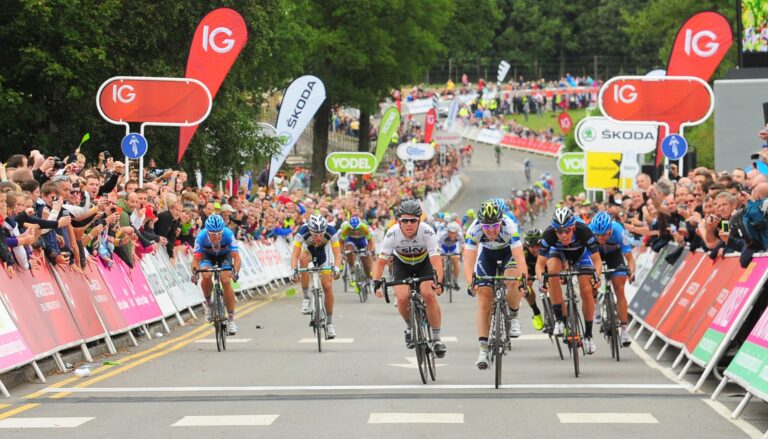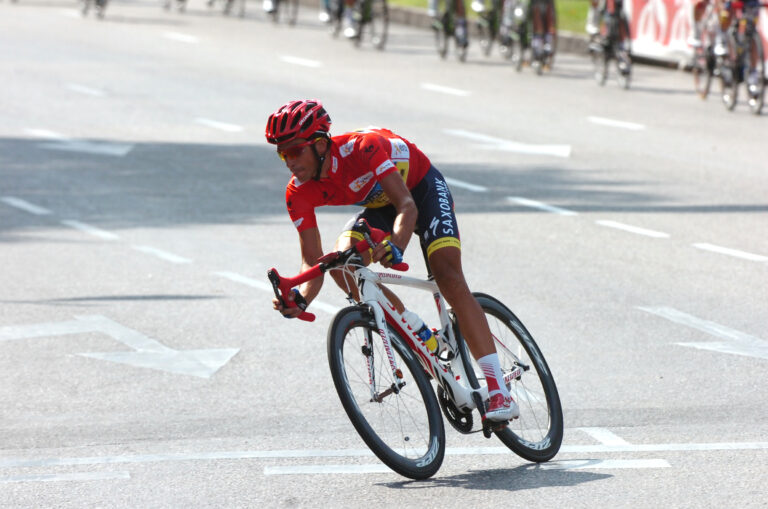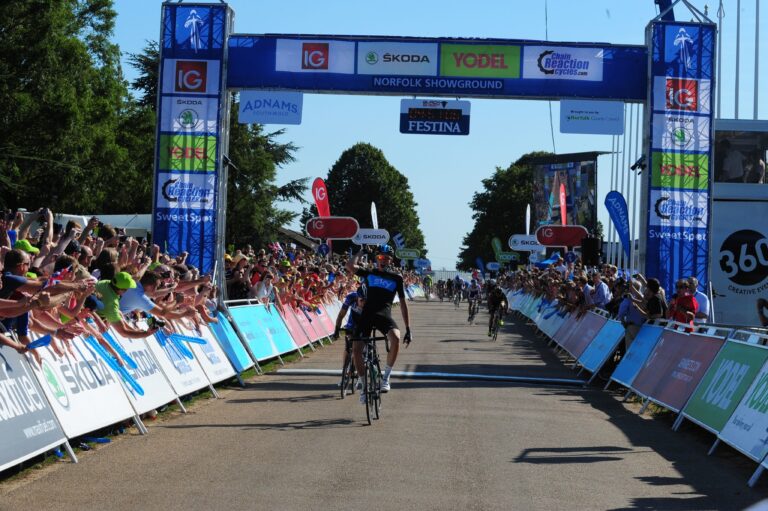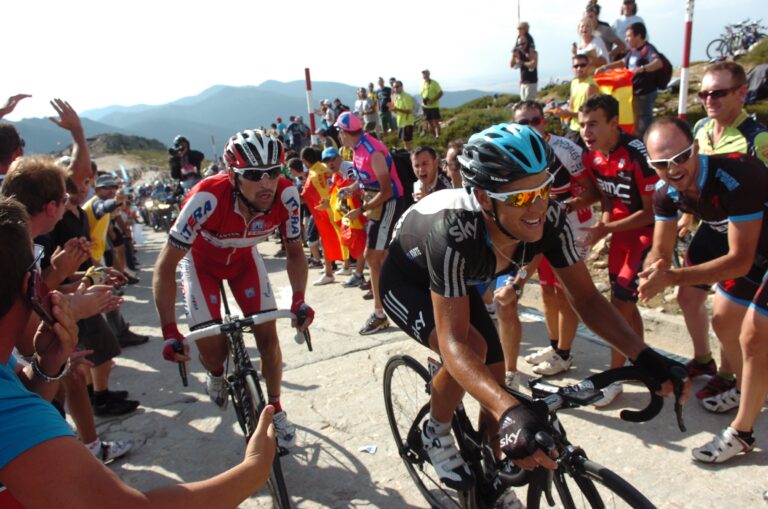No series of articles covering European Sportives would be complete without a report on the ‘Daddy’. This is without question the Tour du Mont Blanc and it’s not for the faint hearted!
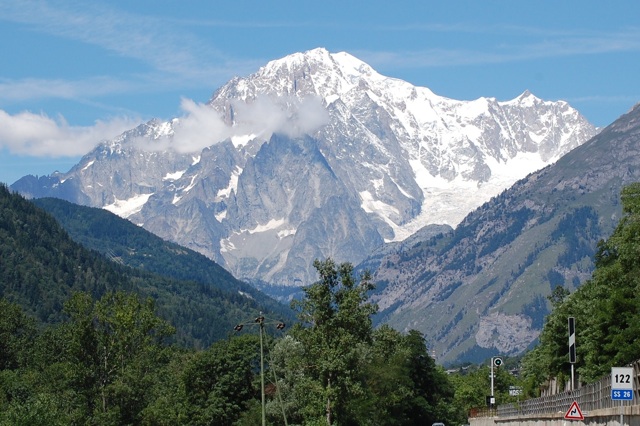
On Sunday the July 22, the third edition of the Tour du Mont Blanc ultra race, started from Les Saisies in the French Alps at 5am. The race travels around Mont Blanc in a clockwise direction and travels through France, into Switzerland and Italy, before returning to French soil. It’s a 330km course with nine climbs (five hors category mountains in succession) totaling just under 9,000m of ascending. It’s regarded as the toughest single stage high mountain event in the world and is described by the organisers as being roughly the equivalent of riding La Marmotte twice (they run both races), in terms of distance and climbing, but the reality of the second half makes it more like three times! It attracts teams from all over the world and many of the world’s best ultra distance racing cyclists, both professional and amateur. The course is based on the two most decisive Alpine stages of the 2009 Tour de France, run as a single race, with the addition of the brutal Col du Champex (HC), which was not included in either of the 2009 stages.
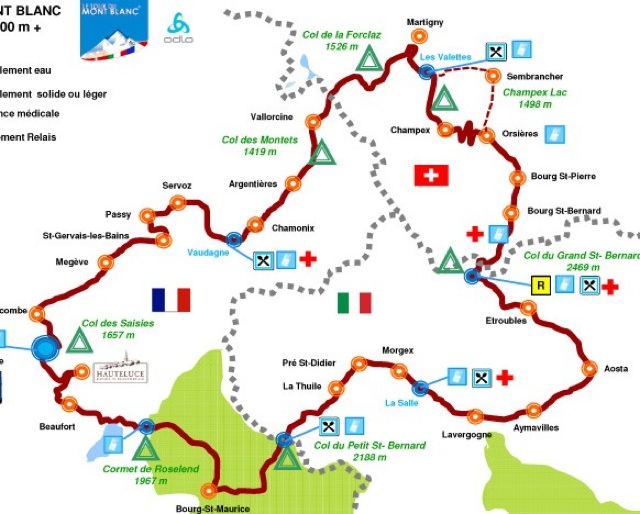
The first edition of the race was in 2010 when 150 brave souls started the event in perfect conditions. Of these, 105 finished and a legend was born! The Tour du Mont Blanc achieved immediate cult status and was hailed by magazines all over the world.
The 2011 event was a rather different story, run in horrific conditions with 50mm of rain, sleet, snow, strong winds and real temperatures as low as two degrees centigrade, with wind chill temperatures on the descents as low as minus 30! Of the 300 entrants at the pre-race briefing on the Saturday afternoon, only 250 were mad enough to be on the start line the following morning. Of these, only 92 finished within the time limit and almost no one finished without one-to-one support and the team cars had to concentrate on the strongest rider. The conditions were unbelievable (it was the same day the French army rescued the Tour de France supporters from the Galibier) and many people suffered from hyperthermia, exhaustion and cramp induced by the cold. In addition, the descents were lethal with rocks and large stones being washed onto the road, many of which resembled small rivers! This was my introduction to the race and I can certainly say I’ve never been as cold in my life! I spent 45 minutes at the top of the Col du Petit St Bernard on the Italian/French border in a bar with a Belgian pro. We were both trying to warm up and were shivering uncontrollably, whilst our support crews were pouring hot drinks down our throats. We must have looked hilarious! Both being slightly mad, we did however get back on our bikes and he went on to finish 10th while I was 16th. My first reaction was surely it will be better next year……
And it was! Conditions were near perfect for the 2012 race and almost 400 riders started, including a total of nearly 30 two-man relay teams, with riders changing at the top of the Col du Grand St Bernard on the Swiss/Italian border, which is roughly halfway. Including the relay option for the first time has opened the race up to a lot more people and this will certainly gather momentum in next year’s event.
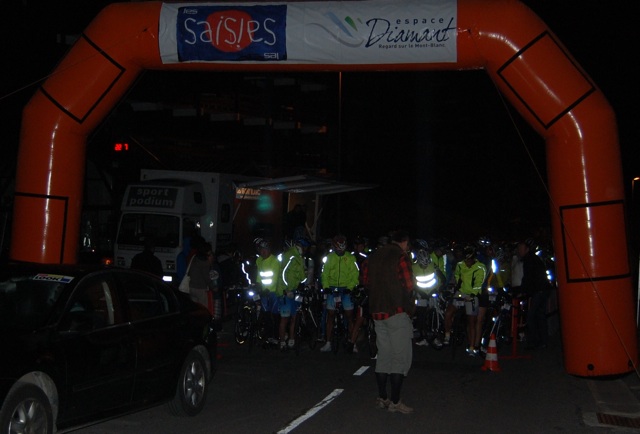
The race starts with a mountain descent to Prazy-sur-Arly in the dark. This is the only part of the course with a rolling road closure and this helps a lot when descending a 1st category mountain before dawn! To comply with French law, lights must be carried to allow you to be seen and the organisers say this is sufficient as the cars and motorbikes will give off enough light for everyone to see. I relied on this advice last year and soon discovered it was useless! Descending a mountain in the dark without decent lights is not to be recommended! This year I used a 950 lumen Exposure Diablo 2 and wow, what a difference! Not only could I see, but I really enjoyed the unique experience and it was a great way to start the race.
The road drops just 650m before turning right into a valley and climbing gently up to Megeve. There were frantic chases at this point as everyone tried to get to the front group and we came together in a bunch of about 50 riders. After Megeve, with dawn very much on the way, the descent resumes down to St Gervais, before the first two climbs of the Col du Joux (3rd cat) and then the Col de Vaudagne (2nd cat) en route for Chamonix. (Although neither of these climbs are mentioned in the briefing as the organisers regard them as insignificant!) The pace on the first two climbs had taken its toll with our bunch reduced to about 15 riders and we all wanted to catch the leading group of 19, which still had a 2 minute advantage. Riding past Chamonix was cold with the freezing air coming off the Mont Blanc glacier, but everyone knew we were about to warm up! We were pushing hard at this stage to take advantage of the only flat section on the valley floor and to make up as much time as possible.
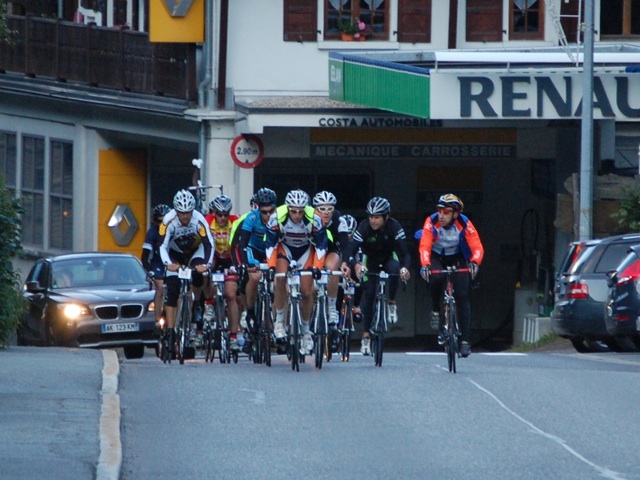
After this, the big climbs start, with the Col des Montets (1st cat) before a great descent to cross the Swiss border at 70kph. Then the Col de la Forclaz (2nd cat), which precedes an amazing descent to Martigny, reaching speeds well in excess of 85kph. At this point, we’d covered c110km at an average speed of 33kph and with a third of the distance ridden and 4 of the 9 climbs, many people were buoyant. However, the valley offers no respite, and you immediately climb the brutal Col du Champex. This is the first hors category climb (HC), and what it lacks in length (only 12km), it more than makes up for in gradient, with many long sections of 12% and the destruction was immediately obvious with what was left of the bunch disintegrating.
From the stunning Swiss ski resort at the top there is dangerous descent on a poorly surfaced road to join the base of the Col du Grand St Bernard (HC) at Orsieres. This 28km climb rises to just under 2,500m and many sections are relatively gentle at 5%, but it saves the best to last! After the last covered section of tarmac, the race takes the old road to the actual ‘col’ rather than the tunnel (where bikes aren’t allowed) and this leaves just 6km to the top. However, after an easy km, the remaining 5kms are at an average of 9%, with sections of +10%. Psychologically this takes its toll on many riders who think they’ve cracked it when they come onto the old road! At the top the temperature was down to 6 degrees and a strong northerly wind made it feel very cold. The relay riders changed at this point, with one lucky rider climbing into the car and the second raring to go. I managed to eat something before crossing the Italian border to begin one of the most amazing descents anywhere. The road surface at the top is incredible and you can hit some fantastic speeds on the descent, but the problem this year was caused by too many cars on the road. The previous events have both been a week earlier before the school holidays and the traffic was much less of a problem. Some drivers are great and wave you past; others are oblivious to the race which leads to some exciting overtaking!

After 40km of descending, you arrive in Aosta and by this stage the temperature had increased to 28 degrees. Benvenuti in Italia! The climbing starts again straight away and the road along the Aosta valley en route for the French border is hard going. The road rises from 580m to nearly 1,100 in 25km, before descending a few times and rising again on the way to Morgex at 950m. There is only 100m of gentle climbing in the next 6km to Pre St Didier, before turning onto the start of Col du Petit St Bernard (HC). Despite the name, this is a very tough climb and the lower slopes were hard work in 28 degrees of heat, which was a shock to the system after a 14 degree summer in Devon! The heat continued until a few kilometres after the beautiful ski resort of La Thuile at 1,700m and then dropped dramatically. The last part of this climb gets steeper and at this point my support driver was giving as many time checks as possible to riders up the road. The danger here is digging too deep to catch people and then blowing up on either of the two remaining HC climbs. Still, I managed to pull back a couple of places on the way to the summit at 2,188m, before crossing back into France, and the amazing descent to Bourg St Maurice. This started well, until I was caught behind a line of about 15 cars. This was very frustrating to say the least, but luckily the ski resort of La Rosiere (at 1,850m) provided an easy overtaking point and I was able to get past all the traffic. With a clear road, I was able to fly down the rest of the descent.
The pattern at the bottom remained the same and it’s immediately onto the Cormet du Roseland. A brutal HC climb rising from 840m to 1,967 in 19km, which seems relatively easy on paper (average of just 6%). The truth however is a little different as most KM sections are 8 or 9% with a couple of negative kilometres the middle. So not only do you climb for only 17 of the 19km, but you actually have to make up for the descending so actually climb 1,200m. This is a soul destroying climb that breaks more people on the race than any other and results in many riders admitting defeat and climbing into support cars (relay riders as well as solo). Last year I had to change bikes after the mid climb descent when the carbon jockey cage on my Dura Ace rear mech decided to shatter. Luckily this year’s ascent was without incident, at least for the bike! The initial part of the final descent starts with a shallow drop down to the lake, before the road steepens dramatically and goes down 950m in 10km! It’s an incredible descent and we were easily able to get past all The cars on the way to Beaufort.
All great Alpine events end with a mountain top finish and the Tour du Mont Blanc does not disappoint! It saves the Col des Saisies (fifth HC) until last, and while many people are jubilant at this point others are very nervous of what’s to come. The climb is only 906m of ascent in the last 15km, but as with the Cormet du Roseland, there are several kms of flat and a few descents. The average gradient of the actual climbing is nine per cent and there are sections of +11%. Having ridden the climb the day before, I felt relatively relaxed and even knew where to take a caffeine gel for maximum effect. The encouragement from my support car was a huge benefit and all the cheering from the other back up teams was a major bonus. It’s this sense of camaraderie that makes ultra races very special. It certainly helped me climb at a good pace and I was able to get to the finish firing on all cylinders.
As with the 2011 event, the race was won by 35 year old Luxembourgian professional, Ralph Diseviscourt who has narrowly been beaten in his national road race championships by the Schlek brothers on several occasions.
I completed the course in 13hrs 51min to take 25th place overall (of 192 solo finishers) and 8th in the 40-49 age category (out of 91 finishers), and was also the highest placed UK based rider. The first three places were all taken by professional riders and many riders in the top 30 were pros.
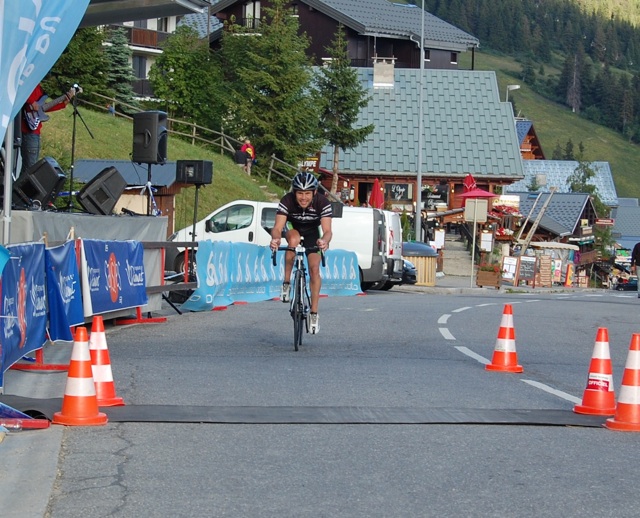
One of the issues facing competitors living away from the mountains is adjusting to the effects of altitude, especially over such a tough event. I got to Les Saisies (1,650m), where the race starts and finishes on the Friday evening. This left just Saturday morning to get a ride in and to try and relax before the 3.30 AM alarm on Sunday morning. Acclimatisation takes over a week, but every extra day spent at high altitude would be a bonus, and next year I plan to be there for 5 days or more before the race which can only help (even if it only aids recovery from the long drive).
The other way to overcome this is to race and train in the mountains as much as possible, which many riders do. I was lucky enough to get in a race in the Vercors Alps (near Grenoble) at the end of May and to then spend a few days training in the mountains staying at www.velovercors.com as a guest of the owners, Roger Dunne and Teresa Harte. Although any benefits made so far in the past would have be exhausted by the time of the Tour du Mont Blanc. I also go to the Belgian Ardennes on a regular basis, and whilst these aren’t exactly mountains, there are many long climbs up to nearly 700m and it’s only three hours from Calais.
Throughout the race I was supported by our team car and had a spare bike and wheels if needed. I was able to take bottles (lots!) from the car and place my food orders! I used carbohydrate electrolyte drinks and took a few extra salt tablets, ate cherry tomatoes, electrolyte gels, half bananas, oat cereal bars, French Madeleine’s, and even croissants with cheese. This combination might not work for everyone, but it does the job for me.
Whilst a large number of riders have support, it’s possible to ride unassisted and many do. When you sign on, you’re allowed to deposit two bags to be taken to the feed stations of your choice. This means you can leave cold weather clothes and lights behind and even leave extra tubes and tyres dotted around the course.
So, will I be back next year? You bet and it can only get better!
Contact me if you’d like to ride next year or for advice on any other European events.
Andrew Thompson started racing in 1983 and has competed in road and off-road events, both in the UK and in Europe. He is a director of Cicli di Tomsoni Ltd, the UK importers of A:xus bikes from Germany and Thompson Bikes from Belgium.


